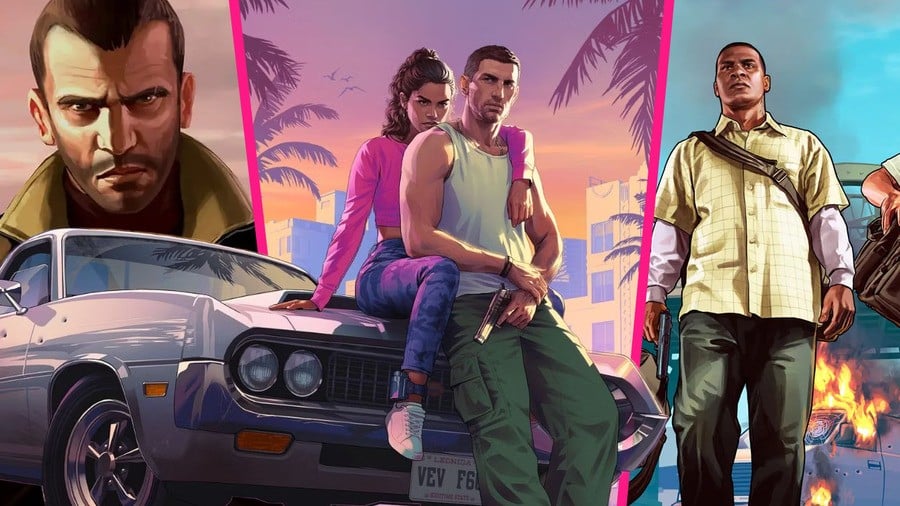
Don't worry – you're not suffering from déjà vu. If you feel like you've read this before, it's because we're republishing some of our favourite features from the past year as part of our Best of 2024 celebrations. If this is new to you, then enjoy reading it for the first time! This piece was originally published on August 26th, 2024.
There are few video game series that have managed to achieve the same level of success than the Grand Theft Auto games.
Originally developed by a small team at the Dundee-based studio DMA Design in the mid-90s, the open-world crime series has since gone on to become a billion-dollar enterprise requiring multiple studios across the globe to work against the clock to ensure its latest entry is bigger, better, and more breathtaking than the one that came before it. Because of this, we're always fascinated to look back at some of the plans for the series that never quite saw the light of day and imagine the roads not taken on its path to superstardom: from playable cities and modes that were announced but never realized to ports of the game that graced the pages of magazines only to disappear from the release calendar without any explanation as to what had happened.
Recently, we've been busy compiling a list of these projects, amassing everything we could find about these projects, trawling through our old archive of interviews for comments from developers, and conducting additional conversations whenever necessary. The list includes everything from early concepts for projects that ended up releasing to versions of the game that were scrapped and wholly original titles that were killed before they had the chance to reach the market. Enjoy!
Race 'N' Chase
Before Grand Theft Auto was Grand Theft Auto, it was being developed under the name Race 'N' Chase. Race 'N' Chase was a very different project from the one that ended up releasing in 1997 across PC and PlayStation in the UK and saw players exploring three cities (described as New York, Venice, and Miami in the design doc) across four different game types.
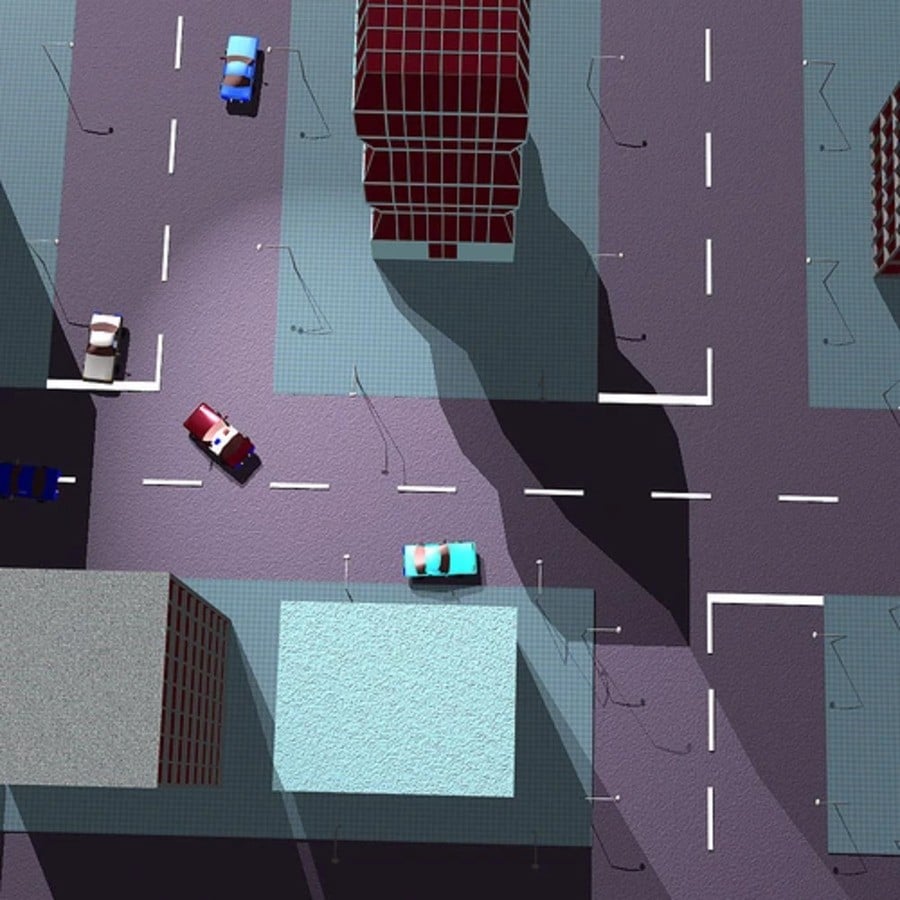
These game types included Cannonball Run (an A to B race across the city), Demolition Derby (a free-roam mode where the winner is the person to wreck the most enemy cars or survive the longest), and two different Bank Robbery modes (one where you play as a getaway driver and must evade the police, and another where you control the police and must stop the robbers' vehicle from escaping). But over time, the team ultimately decided to go in a different direction with the project, choosing to focus more on the criminals than the police. This was then followed by a name change to the iconic title we're all familiar with today.
GTA 64 & GTA Sega Saturn
As we mentioned above, Grand Theft Auto was originally released for the PC and PlayStation, but what you might not know is that two other ports of the game were also planned. These versions were for the N64 and Sega Saturn and were part of the publisher BMG's original agreement with DMA Design. Evidence of these appears in the original design document for Race 'n' Chase as well as various gaming outlets throughout the '90s.
The Sega Saturn version, for example, appeared in Mean Machines Sega (issue 44, June 1996) and Sega Power (Issue 81, August 1996), but was later revealed to have been cancelled in a Saturn Power article (issue 10, February 1998). Meanwhile, the N64 port was considered multiple times throughout the decade and was briefly covered in N64 Mag (issue 29, June 1999) and IGN64 (March 1999), before eventually being put to one side. In the past, we were able to speak to Grand Theft Auto's producer Gary Penn, as well as Brian Baglow, a writer on the original game at DMA Design, who gave us some potential explanations for why these versions were dropped.
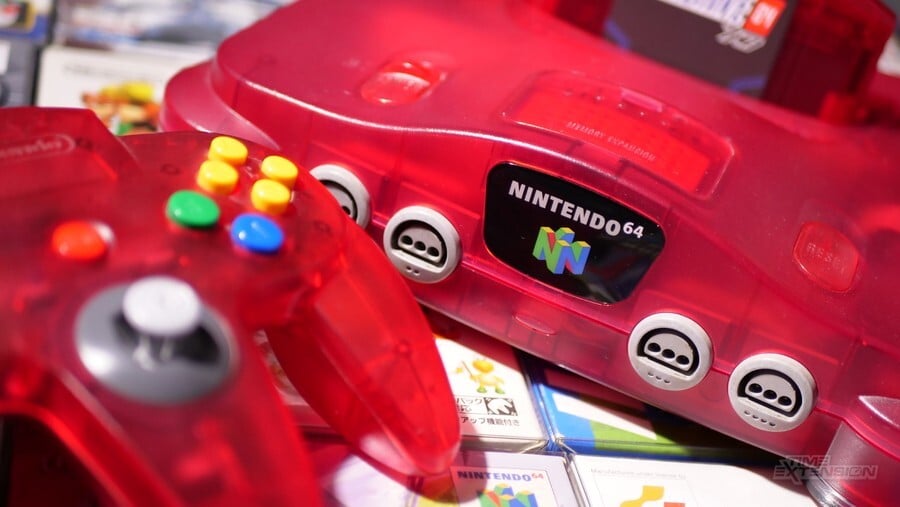
Penn told us, "DMA did a deal with BMG for four products across four SKUs. So 16 versions basically. So it was four versions of GTA. Four versions of Tanktics. Four versions of a game called Covert. And four versions of Silicon Valley. What happened was Nintendo very early on in the deal wanted some sort of [timed] exclusivity so I think we chose Silicon Valley in the end to be the exclusive.
What happened was Nintendo very early on in the deal wanted some sort of [timed] exclusivity so I think we chose Silicon Valley in the end to be the exclusive. So what that effectively did was it took N64 off the table for all the other games.
"So what that effectively did was it took N64 off the table for all the other games. So there would be no N64 GTA, no N64 Tanktics, and no N64 Covert. So it went from 16 versions to 13. So we immediately lost three versions. And then what happened with the Saturn version is that it also had to be dropped because it was just too problematic. We had to cut them just to make sure we could focus on the other versions. So the decision was made just to focus on PC & PlayStation."
Baglow, meanwhile, added, "Each of the platforms that were out there at the time had vastly different capabilities. Different storage systems and so on, and we were leading with the PC version, which is arguably the most powerful. So that was being built — the tracks were going down in front of the train in a lot of places — and the idea of rewriting a different engine for the N64 and then figuring out how to strip content and strip capabilities made no sense. The same with the Saturn version. I seem to remember Alan Campbell working on that, but I don’t know how far he got."
GTA 1.5
Before development on Grand Theft Auto 2 officially started, the idea was floated inside DMA Design to work on an expanded version of the first game, as opposed to a sequel. This is according to the ex-DMA Design producer Gary Penn.
In an interview from a few years ago, he told us, "GTA 2 was going to be just a remake of 1 tidied up. It wasn’t intended to be a cynical thing. It was kind of like GTA 1.5. These days you might think of it in terms of DLC, or a remaster with DLC, which was a great idea because the first one was manky as fuck and really needed fixing. So that’s how it started." According to Penn, the reason this project never ended up seeing the light of day was because when Take-Two bought the rights to Grand Theft Auto, it decided to scale up the project, hoping to do "a full-blown sequel" instead. As a result, DMA ditched the original three maps (Liberty City, Vice City, and San Andreas) in favour of making a futuristic sequel set in the cyberpunk metropolis of Anywhere, USA.
GTA 2 N64
Much like Grand Theft Auto 1, the second game was also briefly considered for N64 at the start of its development. Very little is known about this project and how far it got, with the only evidence of its existence being a brief mention in a Take Two SEC filing from 1999 and some mentions in publications like IGN and the video game magazine GameMaster.
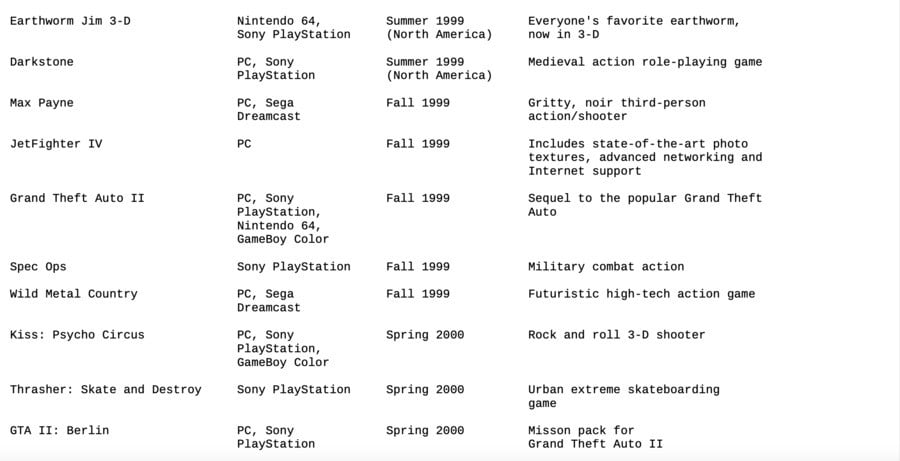
GTA 2: Berlin
Shortly after the release of GTA 2, Take-Two announced it would be producing an expansion pack for the game, called GTA 2: Berlin, similar to how Grand Theft Auto: London 1969 and Grand Theft Auto London 1961 had been released in the wake of the first game.
The expansion was mentioned in a couple of German magazines in 1999 including PC Games (October 1999) and Play The PlayStation (December 1999), and was also mentioned in an SEC filing from Take Two. According to these separate news sources, the game was going to be released in Spring 2000 for PC and PlayStation and would have been set in the 80s, before the fall of the Berlin Wall. It would also have featured a period-appropriate soundtrack, which was to be comprised of German New Wave music. The reports stated the game was being developed under Take-Two's German division, but no one we spoke to at Rockstar Toronto and DMA Design could remember the project when we asked them about it.

Recently, though, we were able to contact a regional sales manager for Take-Two in Germany during this period as well as someone from Rockstar New York, who were able to shine a bit more of a light on this lost entry into the series.
In a message, the regional sales manager told us, "As far as I can remember, there was indeed the idea back then to create an extension with Berlin's districts for GTA. The plan included Underground rides through the expansive Berlin, as well as visits to the Berlin radio tower, and of course, everything with German car brands. I would have to look through my archives to see if I still have anything concrete on that."
As far as I can remember, there was indeed the idea back then to create an extension with Berlin's districts for GTA. The plan included Underground rides through the expansive Berlin, as well as visits to the Berlin radio tower, and of course, everything with German car brands
The manager later went on to add the expansion was probably "a cooperation between the team from Scotland and a German team from near Munich and of course, people from Berlin", but said they weren't 100% sure. They suggested Christoph Hartmann, a former vice president of international marketing at Take-Two might know more about the development and why it never ended up coming out, but our attempts to contact Hartmann have so far been unsuccessful.
We did, however, manage to reach out to someone who worked at the Rockstar New York office during this period, who gave us a potential answer on why Rockstar didn't want to go ahead with the project. They told us, "With GTA Berlin and the other stuff, what you tended to have was the other people under the Take-Two umbrella sitting in the remote offices getting big ideas and trying to run with it before realizing that’s not how the lay of the land worked. We’d get a call like, ‘Hey, what do you feel about GTA Berlin?’ ‘Fuck off, go away.’”
It's currently unknown if any work was actually completed on the project, or if it simply remained an idea on paper. So we'll keep digging to see if we can uncover more.
GTA 2000
After work on Grand Theft Auto London 1969 and Grand Theft Auto London 1961 was finished, Rockstar Toronto briefly worked on a mission pack called GTA 2000, which was intended to be distributed as a magazine cover disk, before it was eventually cancelled.
Not much is known about the project, but back in 2022, Raymond Larabie, an artist on the GTA London games told us the following about what he remembers from his limited involvement with the project:
"Rockstar Toronto was working on a mission pack for a magazine cover disc called GTA 2000. I didn't get to see what it was about, but I made a graphic for a space shuttle ruin on Mars that was to be used in the game, so I assume it took place on Mars. I think it was cancelled before much of it got done. It was never intended to be a full-length game, just a quick game. I don't think there were playable missions, as it got cancelled so soon after it started. I never heard any reason for the cancellation, but it's strange that it never makes any of the lists of cancelled games.
He continued, "I remember seeing Ed Zolnieryk working with the GTA 2 code, and I saw my space shuttle graphic in the game or the editor on his monitor. I was probably too busy with Max Payne PS2 at that point to pay much attention to it."
GTA Online Crime World
In an SEC filing, dated March 23rd, 1999, Take-Two wrote that it was "currently developing a multi-player on-line version of Grand Theft Auto and we intend to develop additional multi-player on-line versions of our titles in the near future."
While no name was given for this project in the filing, later in the year, the company announced the development of GTA Online Crime World shortly after Take-Two acquired DMA Design in September 1999, along with GTA 3D (the game that would eventually become GTA III). GTA Online Crime World would later go on to be mentioned on early online gaming websites like Gamespot as well as within the pages of magazines like PC Zone (issue 83, December 1999), and was reportedly set to build on the network multiplayer experiences previously included in games like Grand Theft Auto 1 and 2, and Grand Theft Auto London 1961.
It's unknown whether the project was going 2D or 3D, or how far exactly it got, but incidentally, the following year, in March 2000, Take-Two revealed an ambitious plan to merge Rockstar Games and DMA Design with an Israeli tech company Pixel Broadband to form a new entity called Broadband Studios, which would enable the other participants in the deal to use Pixel Broadband's priority software Jive to make subscription-based, high speed, multi-player online games, for those with a broadband connection. It's not a huge leap in logic to assume that these two initiatives may have been linked, but as the former DMA Design and Take-Two employee Brian Baglow told us, "the idea [behind the merger] went nowhere", with a few press releases and articles being all that remains to suggest it was ever going to happen.
There was lots of things that started. Like there was talk of a GTA MMO. There was one in the works at one point, it’s just nothing ever came of it. It was just never the right project.
Interestingly, while talking to the former Rockstar director of development Susan Cummings, she also mentioned that a GTA MMO was also talked about within the company, stating "There was lots of things that started. Like there was talk of a GTA MMO. There was one in the works at one point, it’s just nothing ever came of it. It was just never the right project."
Obviously, as we know now, GTA IV would eventually reintroduce online multiplayer to the series in 2008, bringing with it a bunch of playable game modes as well as a free play option letting you explore Liberty City with friends and strangers. GTA V, meanwhile, expanded on this further in 2013, letting players roam a version of San Andreas populated with other people to compete in races, roleplay as their own original characters, and embark on a separate story to the main plot, among other things.
"Godzilla Takes Manhattan" / GTA III (Dreamcast)
Prior to the development of Grand Theft Auto III for PS2, the project initially started as a demo for the Dreamcast, which the DMA producer Gary Penn affectionately calls "Grand Theft Auto: Godzilla Takes America".
This project wasn't originally meant to be an official GTA project but was instead a 3D tech demo of a city that the Space Station Silicon Valley team lead Leslie Benzies and a couple of programmers brought into the office one day, shortly after finishing work on that project. At the time, the GTA 2 team was completing work on that title in 2D, while elsewhere in the studio, another team had started development on what would eventually become Manhunt. But the Space Station Silicon Valley had nothing to move on to, so Gary Penn assembled a group of DMA developers and began spitballing ideas for other city-based concepts.
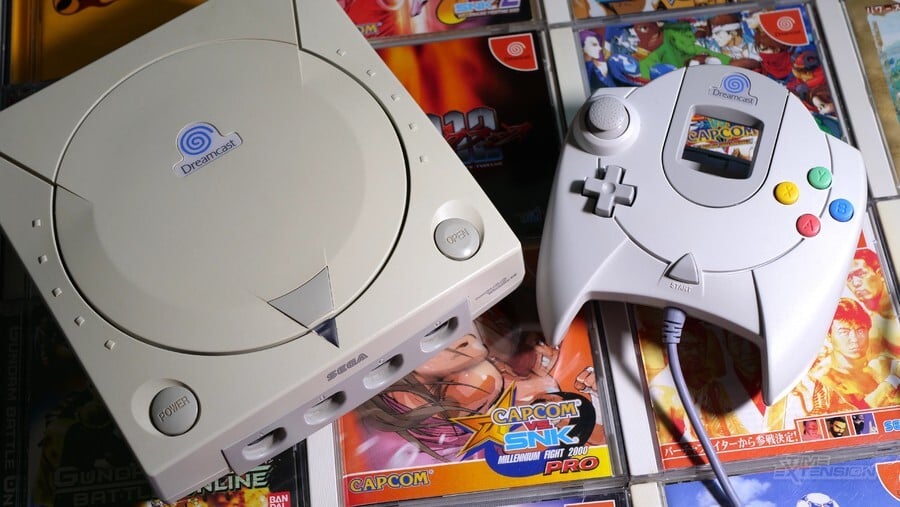
“It had essentially grown out of a combination of Body Harvest's open-world roaming mechanics and Space Station Silicon Valley's final level with a city full of vehicles,” said Alan Jack, a former support engineer at DMA Design. “They had built a tech demo on a Dreamcast dev kit that demonstrated cars whizzing around in 3D, with beautiful lights and full deformation on the car bodies. I remember that Gary basically didn't want to kill their creativity, [so he] gathered a few of us office loose ends together and said ‘Let's make something that is 3D, uses this city prototype, and is on the Dreamcast’”.
It was at this the DMA co-founder David Jones recommended that they turn it into a Kaiju-themed project, with Jones supposedly informing the team that he may be able to land the rights.
He had proposed a system whereby one trigger would control the neck and the other the jaw, which created this little core challenge of carefully picking things up (people/eggs/boxes) and not properly crushing them.
"I remember Gary being rightly excited about the Dreamcast's analogue controller triggers," said Jack. "He had proposed a system whereby one trigger would control the neck and the other the jaw, which created this little core challenge of carefully picking things up (people/eggs/boxes) and not properly crushing them. We had a few sketched gameplay systems where you had to rescue/defend eggs, or you could pick people up and carry them as hostages."
Penn, meanwhile, informed us about another design, one that would see the monster rampaging through the city: "You stomped around, you’d eat people and grow, and then you'd destroy even more things. And the idea was as you ate and destroyed, you’d grow and you’d eat and destroy some more. They had got the guts of that working on Dreamcast."
If you're wondering why this project never made it to release, the answer is quite simple. In September 1999, Take-Two bought DMA from Infogrames for $1 – plus the assumption of certain debts the developer had accrued – bringing with it a number of sweeping changes to the studio. This included moving DMA from its historic home in Dundee to a new location in Edinburgh, where it became Rockstar North, and consolidating the Silicon Valley and Grand Theft Auto II developers into a single team. It was at this point that a decision was made to use the technology from the demo. Development of Grand Theft Auto III continued on Dreamcast, but exactly how long this version of the game was worked on or how far these experiments got depends on the source.
In 2023, Aaron Garbut, the current co-studio head at Rockstar North, told Game Informer about the Dreamcast tech demo, "When we finished our first game at DMA Design, we had some time to prototype and come up with ideas. We also got access to a couple of Dreamcast devkits. Over several weeks, we managed to create a number of blocks of a city with docks, retail areas, and brownstones. We were playing, really, but we added characters walking the streets and cars driving around."
The former Rockstar North programmer Obbe Vermeij, meanwhile, had a slightly more conservative view of these early Dreamcast experiments on Twitter, saying that they simply resulted in a simple demo featuring a basic character walking around. He stated that the project ended up being switched to PS2 "when it became clear the DC was not commercially viable" and called it "a shame" as the team was huge fans of Phantasy Star Online at the time.
